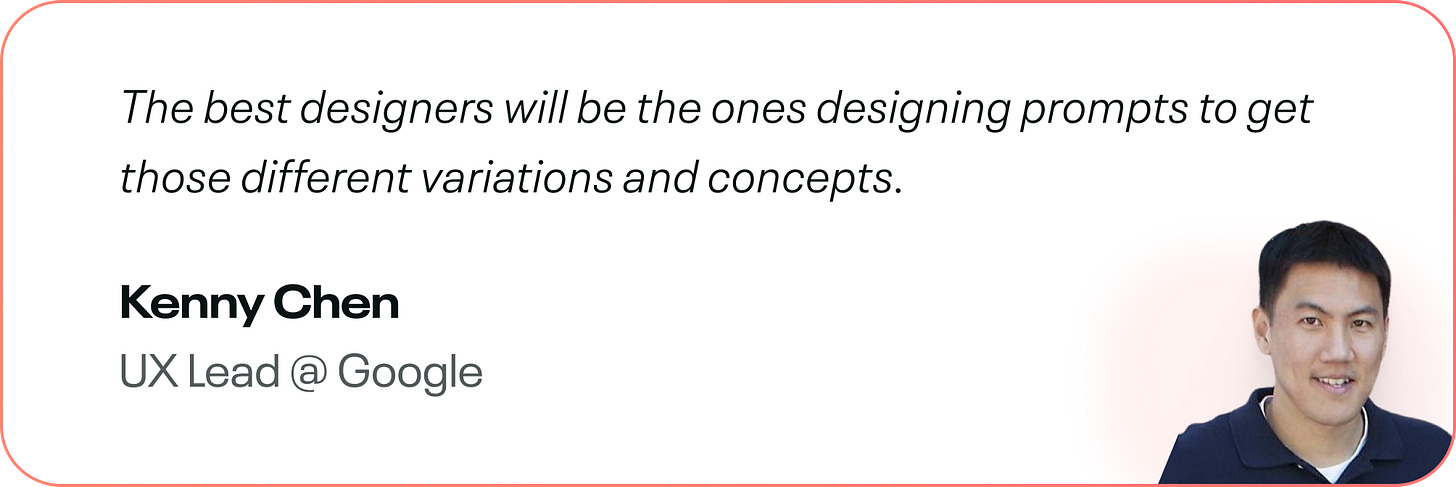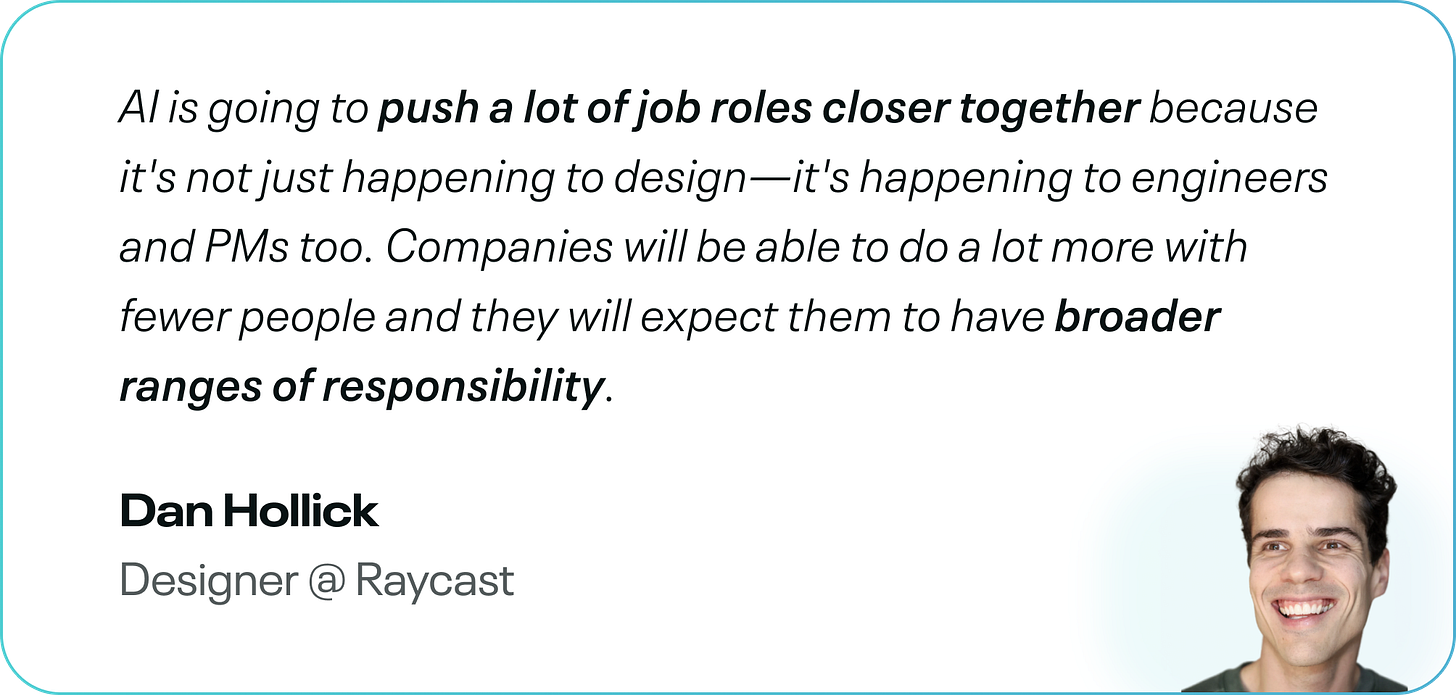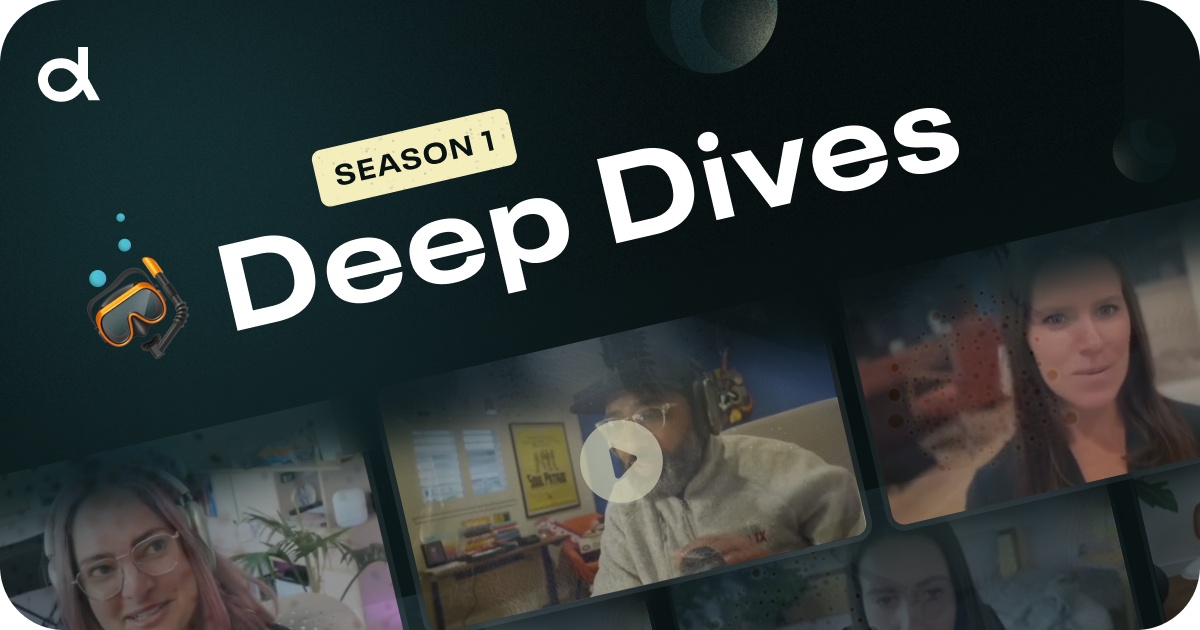Design Tactics #18 — AI and the designer of the future
How to succeed as a designer in an AI world
Somehow diving into the latest Figma tactics feels less important than it used to (well, at least until Config anyway 😄).
The truth is that I can’t stop thinking about the impact of AI.
Specifically, how can designers set themselves up for success in an AI future?
I’m hungry to learn. So over the last month, I’ve made a point to talk to as many smart people about AI as possible. It’s actually one of the main drivers that led me to launch 🤿 Deep Dives.
In this article, I’m going to attempt to summarize the key takeaways from those discussions and tie it all together with some of my own ideas.
Let’s dive in 👇
What does AI mean for design?
The first-order effect of AI is probably the most obvious one so we’ll start here 👇
Design (and software in general) is about to become much more efficient.
Almost all of the second-order effects stem from the reality that we’ll soon be able to do our jobs in a fraction of the time.
But if the initial 80% of work is taking us <20% of the time…
What does that mean for the role of a designer?
Well, quite a few things 👇
“Taste” becomes more important
I believe AI is going to place a premium on “taste” for designers.
When design is fully democratized by prompt engines… one of the distinguishing factors is going to be knowing what “good” looks like and being able to confidently articulate it.
(side note: it reminds me of this 30-second Rick Rubin clip if you haven’t seen it)
This makes me even more excited to invest in my own visual library of inspiration. Because tools like Uizard already allow me to feed AI images and then transform an entire set of screens to match that visual style.
Before I go any further, I want to be clear though… the current state of AI tooling mostly sucks. We have a long way to go before I’m using UI-generation tools in my day to day. But the future seems pretty obvious 👇
My ability to feed AI the right inputs (both text and visual) is going to directly translate into my success as a designer.
This means the best time to start collecting and organizing visual inspiration is now.
Ingenuity > output
AI will empower us to 10x the number of explorations we can do within a given problem space. Time no longer becomes the primary constraint. Instead, our ceiling is only capped by our ingenuity.
So much of what we value in designers today is tied to output:
how many projects can you handle?
how many docs can you write?
how many screens can you crank out per week?
But when output is essentially uncapped, our value is tied directly to the quality of our ideas.
On one hand, craft enthusiasts will be able to visualize even more concepts for that next feature card animation… but I’m even more interested in how wide we’ll be able to go in early product explorations.
We’re going to be able to blitz past the obvious ideas… which will test our grasp of product strategy. And that’s why I believe AI is going to reward designers who have a strong product sense 💰
Roles will start to converge
Sometimes it’s easy to forget that designers are not the only ones panicking over the potential impact of AI 👇
AI is going to empower anyone to design, code, write SQL queries, build automations, etc. And that’s going to make the lines between traditional roles on a product team pretttty blurry…
It’s time to expand the surface area of how we define our role as a “designer”.
I see this primarily happening in two ways:
Designers moving more into strategy/business 👩💼
Designers moving more into production code 👨💻
I’ll explore both of these ideas next, but first I want to make it clear that you don’t need to pursue both directions at once.
That being said, I do think it’s important for designers to start investing in a skillset that cements their value in the long run. Especially as we move towards a world where AI is playing a dominant role in how we build software companies.
Moving into strategy/business
AI is going to empower more designers to move up the value chain.
We love to talk about increasing our impact and getting a seat at the table. Well… AI might be the greatest catalyst yet. By reducing the bulk of our current workload we’re going to be freed up to start strategizing about the bigger, meatier problems.
By the way… if you’re looking to level up your business understanding, I recently shared 3 ways to increase your influence as a designer from my interview with Mia. She shares a ton of great advice for learning business acumen from your PMs and translating the value of your work through “investments”.
Moving into production code
Framer is the tip of the iceberg… we’re entering a world where design isn’t going to be painting pretty pictures of what a product could look like. We’ll be expected to contribute directly to the product itself.
I first wrote about this idea in 2021 but I assumed Figma would be the team to pull the future forward. Maybe I’m a bit less confident in that part of the prediction now, but I’m also very interested to see how AI shapes their product roadmap at Config next month. I have a hunch they’ll be announcing something in this realm 👀
Regardless of how it shakes out, designers need to become builders.
"Should designers learn to code?” is now the wrong question. Because the answer, in my opinion, is unequivocally “no”. Learning syntax is very low ROI when AI can write it for you.
But the value of “technical literacy” has never been higher. Learning how code and data actually works is one of the best ways you can invest in your future skillset.
I care deeply about this topic and am working with Nick on a program to help designers level up in this area. We just filmed a pretty epic video last week so hop on this waitlist if you want us to send it to you.
I don’t know much syntax anymore, but I understand enough about how code works that I was able to write some pretty nifty Javascript using ChatGPT the other weekend and I felt like a superhuman.
Now that I see what is possible with AI, I’ve never felt more conviction that the most valuable designers will be the ones who can build their ideas.
Now you probably have one of two reactions to the above:
Excitement 🙌
Intimidation 😬
If you’re in camp #1 and want to get nerdy, Dan Hollick recently released a fun video about using Framer and GPT4.
If you’re in camp #2, that’s expected and totally ok :)
My advice is to approach AI tooling as an opportunity to play. Because the fact is… AI is pretty fun!
In my interview with Femke, she explained how she hasn’t historically considered herself a “builder” but she’s still trying to tinker with AI just to see what it can do.
I definitely did not interview Scott Belsky on Deep Dives (maybe season 2 lol) but he recently shared similar advice on an episode of Lenny’s Podcast
Playing isn’t limited to tools that impact your job either. Pay attention to different products that push the visual paradigms associated with LLMs. We’re still figuring out what AI looks like as an industry. Here are a few products I have my eyes on:
Moving forward
I have some more thoughts on how AI will shape design systems and also how it might impact the broader talent market for design (spoiler: it’s not all bad 😇).
But it’s late and I’ve decided that I’m going to save those for another article :)
I know this topic and the rate of change can be intimidating, but my aim is to inject a bit of hope into your outlook.
Is it possible to get passed up by AI if you don’t adapt? For sure.
But for the designers who stay curious and invest in themselves… I think AI is going to massively increase the level of impact that we’re able to have in our day to day. Whether that’s building our ideas, shaping company strategy, or even using our newfound efficiency to branch out and do our own thing.
The future is bright my friends 🌞
— Ridd
P.s. I’m going to work hard to make Deep Dives the highest-value podcast for designers. There are already some epic guests lined up for season 2 and you can get all of season 1 here 🤿
















thank you, ridd! have been meaning to learn more about AI and how it can applied as a designer, and this article has been a great jumping off point for me.
also, big fan of your youtube! my hands down favorite design channel for improving my tactics and workflow 🙌
This is super insightful, Ridd. Thanks for sharing, I would love to share this in my newsletter, loved it!!